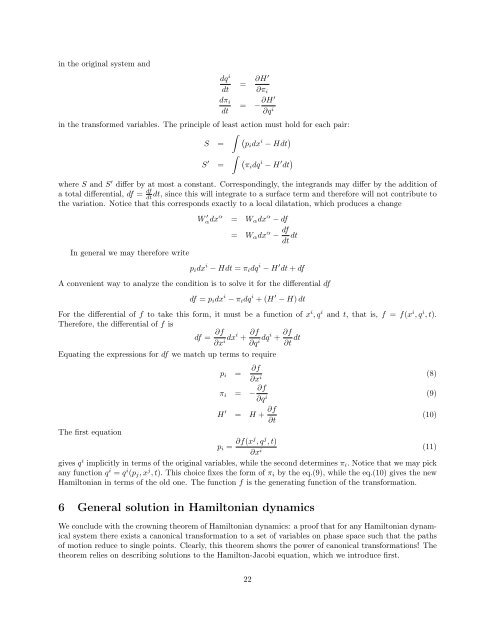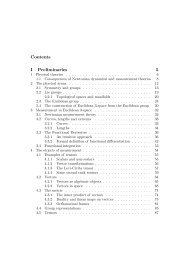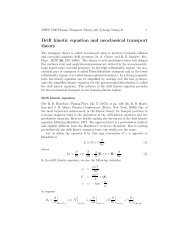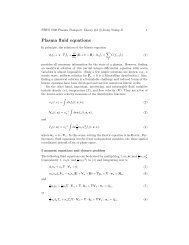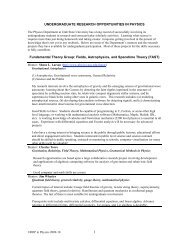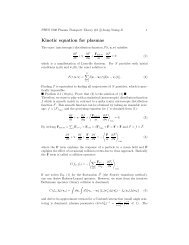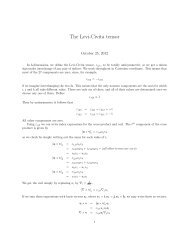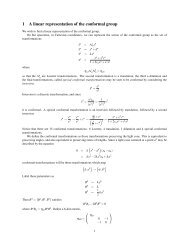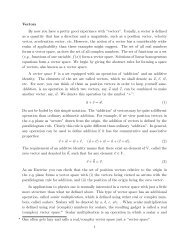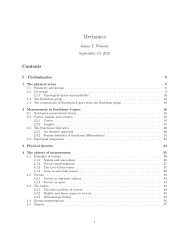Hamiltonian Mechanics
Hamiltonian Mechanics
Hamiltonian Mechanics
You also want an ePaper? Increase the reach of your titles
YUMPU automatically turns print PDFs into web optimized ePapers that Google loves.
in the original system and<br />
dq i<br />
dt<br />
dπ i<br />
dt<br />
= ∂H′<br />
∂π i<br />
= − ∂H′<br />
∂q i<br />
in the transformed variables. The principle of least action must hold for each pair:<br />
ˆ (pi<br />
S = dx i − Hdt )<br />
ˆ (πi<br />
S ′ = dq i − H ′ dt )<br />
where S and S ′ differ by at most a constant. Correspondingly, the integrands may differ by the addition of<br />
a total differential, df = df<br />
dt<br />
dt, since this will integrate to a surface term and therefore will not contribute to<br />
the variation. Notice that this corresponds exactly to a local dilatation, which produces a change<br />
In general we may therefore write<br />
W αdx ′ α = W α dx α − df<br />
= W α dx α − df<br />
dt dt<br />
p i dx i − Hdt = π i dq i − H ′ dt + df<br />
A convenient way to analyze the condition is to solve it for the differential df<br />
df = p i dx i − π i dq i + (H ′ − H) dt<br />
For the differential of f to take this form, it must be a function of x i , q i and t, that is, f = f(x i , q i , t).<br />
Therefore, the differential of f is<br />
df = ∂f<br />
∂x i dxi + ∂f<br />
∂q i dqi + ∂f<br />
∂t dt<br />
Equating the expressions for df we match up terms to require<br />
The first equation<br />
p i = ∂f<br />
∂x i (8)<br />
π i = − ∂f<br />
∂q i (9)<br />
H ′ = H + ∂f<br />
∂t<br />
p i = ∂f(xj , q j , t)<br />
∂x i (11)<br />
gives q i implicitly in terms of the original variables, while the second determines π i . Notice that we may pick<br />
any function q i = q i (p j , x j , t). This choice fixes the form of π i by the eq.(9), while the eq.(10) gives the new<br />
<strong>Hamiltonian</strong> in terms of the old one. The function f is the generating function of the transformation.<br />
6 General solution in <strong>Hamiltonian</strong> dynamics<br />
We conclude with the crowning theorem of <strong>Hamiltonian</strong> dynamics: a proof that for any <strong>Hamiltonian</strong> dynamical<br />
system there exists a canonical transformation to a set of variables on phase space such that the paths<br />
of motion reduce to single points. Clearly, this theorem shows the power of canonical transformations! The<br />
theorem relies on describing solutions to the Hamilton-Jacobi equation, which we introduce first.<br />
(10)<br />
22


